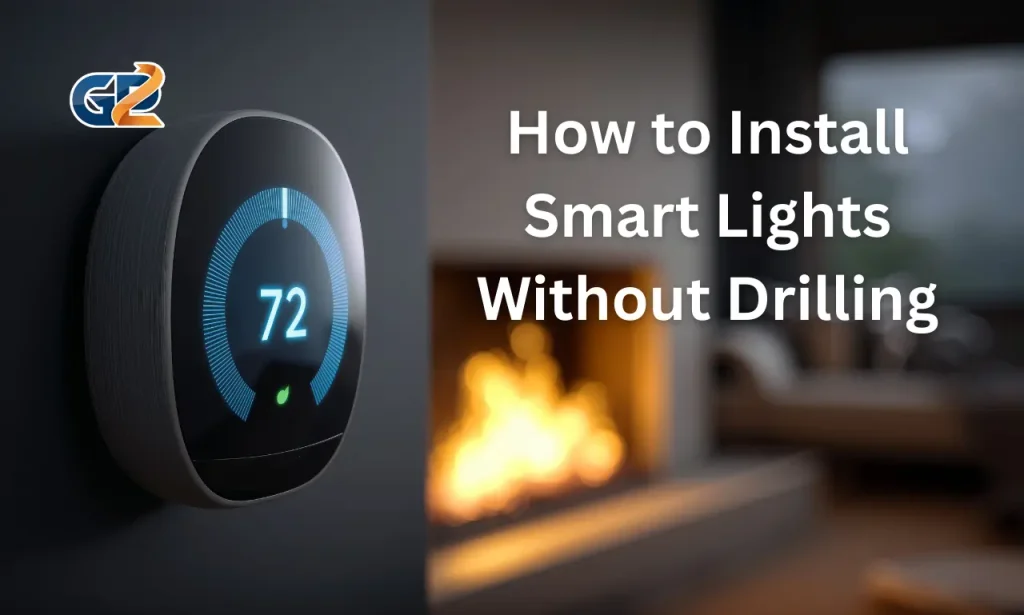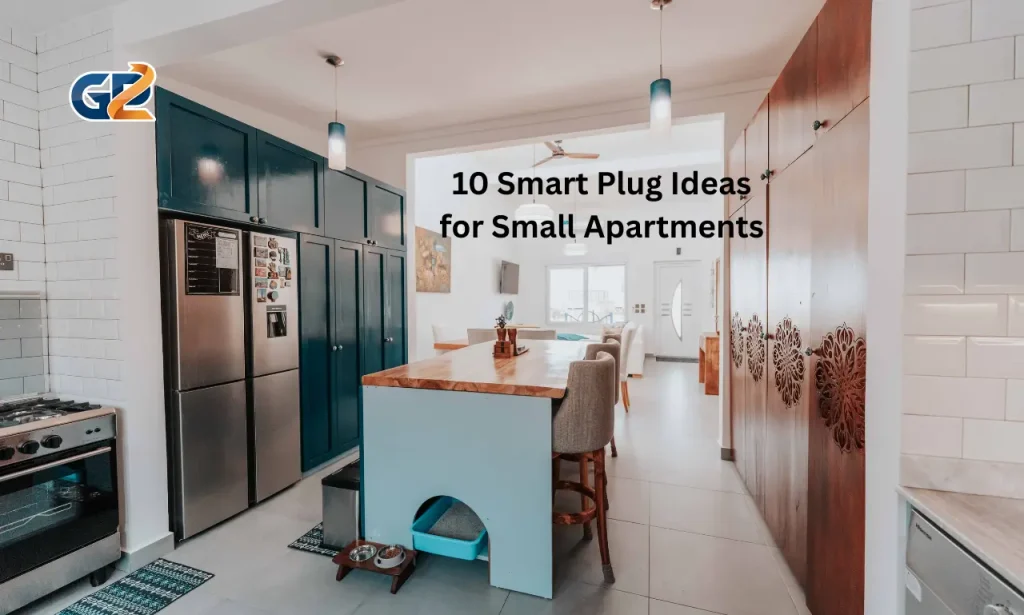Smart lights are modern lights that you can control with your phone or voice. You can turn them on or off, change their brightness, and even pick different colors. Some smart lights can follow schedules or react to your home’s activities. They make your home more convenient and can save energy. You don’t need to touch a switch every time.
Drilling can damage walls and leave holes that are hard to fix. If you live in a rented home, drilling may not be allowed. Installing lights without drilling is faster and cleaner. You can move your lights whenever you want without leaving marks. No-drill methods use adhesives, clips, or magnets, which are safe for walls and furniture.
Table of Contents
Benefits of Installing Smart Lights Without Drilling
- No Wall Damage: Keeps walls and ceilings completely safe. Ideal for rented homes where drilling isn’t allowed. You won’t have to worry about patching holes or leaving marks.
- Quick and Easy Setup: Installation is simple and fast. You can use adhesives, clips, or magnets without needing drills, screws, or extra tools.
- Flexible Placement: Lights can be moved or repositioned easily. This allows you to change your room layout, adjust lighting angles, or refresh your room’s style anytime.
- Safe Installation: Eliminates the risk of hitting hidden electrical wires, pipes, or other wall structures. You can install lights confidently without accidents.
- Easy Upgrades: Adding or replacing lights is hassle-free. You don’t need to undo screws or patch holes, making it convenient to upgrade your smart lighting system.
- Clean and Neat: No dust, debris, or messy drilling process. Your home stays clean and ready for use immediately.
Types of Smart Lights Suitable for No-Drill Installation
Stick-On LED Strips
These are flexible LED strips with strong adhesive backing that can stick to almost any clean, smooth surface. They are perfect for under cabinets, shelves, around mirrors, or along walls and ceilings to create ambient lighting.
Many strips allow color changes, dimming, and scheduling through smartphone apps. Some even sync with music or TV for dynamic lighting effects. They are lightweight, easy to cut to size, and provide a modern look without drilling or permanent installation.
Battery-Powered Smart Bulbs
Battery-powered smart bulbs run without fixed wiring or wall sockets, making them highly versatile. They can be used in portable lamps, clip-on holders, or outdoor areas like patios and balconies.
You can control them using apps or voice assistants, set timers, and adjust brightness and colors for different moods. They are ideal for temporary setups, rental homes, or rooms without easy access to power outlets, providing smart lighting flexibility anywhere in the house.
Clip-On and Magnetic Lights
These smart lights come with clips or magnetic bases for easy attachment to a variety of surfaces. You can clip them to shelves, mirrors, desks, or cabinets, or attach them to metal surfaces like refrigerators or metal frames. They are lightweight, portable, and can be repositioned quickly whenever needed.
Many models allow brightness adjustment or color changes, making them suitable for reading, workspace lighting, or accent lighting in small apartments and rented homes without any wall damage.
Steps to Installing Stick-On Smart Lights
1. Prepare the Surface
Clean the area where you want to place the lights. Use a dry cloth or mild cleaner to remove dust, dirt, and grease. A clean surface helps the adhesive stick properly and prevents the lights from falling off.
2. Measure and Plan Placement
Measure the space and plan the layout before sticking the lights. Decide the length, corners, and curves where the lights will go. This ensures a neat and even installation.
3. Peel and Stick the Lights
Carefully peel off the adhesive backing and press the strip onto the surface. Start from one end and work slowly to avoid air bubbles. Press firmly along the strip to secure it.
4. Connect Power or Battery
Plug in the lights if they are USB-powered, or insert batteries if they are battery-operated. Make sure the connection is secure before testing.
5. Test the Lights
Turn on the lights using the app, remote, or switch. Check that all sections light up evenly. Adjust the placement slightly if needed to get the best effect.
6. Secure for Long-Term Use
If needed, use extra adhesive clips or holders to secure corners and bends. This prevents sagging or peeling over time, ensuring your lights stay in place.
Installing Battery-Powered Smart Bulbs Easily
Battery-powered smart bulbs are very convenient because they don’t need wiring or wall sockets. Start by choosing a compatible lamp, fixture, or clip-on holder. Make sure it can safely support the bulb and is positioned where you want the light. This helps avoid accidents and ensures the bulb works effectively.
Next, insert the batteries following the instructions. Check that the positive and negative ends are aligned correctly. Using fresh batteries will make the bulb work efficiently and last longer. Once the batteries are in, place the bulb into the socket, lamp, or clip-on holder. Make sure it sits firmly and won’t fall or tilt.
After installation, switch on the bulb to test it. Check the brightness, color options, and any preset modes. Adjust the placement if the light is uneven or not pointing in the right direction. This ensures the lighting looks good and works as intended.
Connecting Your Smart Lights to Apps and Voice Assistants
Smart lights become truly convenient when connected to apps or voice assistants. Start by downloading the manufacturer’s app on your smartphone or tablet. Most apps are available for both Android and iOS. Open the app and follow the instructions to create an account or sign in.
Next, put your smart lights into pairing mode. This usually involves turning the lights on and off in a specific pattern or pressing a small button on the device. Once in pairing mode, the app should detect the lights automatically. Follow the prompts to connect them to your home Wi-Fi network.
After connecting to the app, you can customize your lights. Adjust brightness, colors, schedules, or set timers directly from your phone. Many apps also allow grouping multiple lights together to control them simultaneously.
Common Mistakes to Avoid
- Installing on Dirty or Uneven Surfaces: Adhesives may fail if the surface is dusty, greasy, or uneven. This can make lights peel off or fall, causing damage or inconvenience. Always clean and dry surfaces thoroughly before installation to ensure a secure hold.
- Using the Wrong Adhesive or Mounting Method: Not all adhesives or clips work on every surface. Using the wrong type can damage walls, furniture, or reduce the stability of the lights. Check the surface type and choose the appropriate mounting method for long-lasting installation.
- Overloading Power Sources: Connecting too many lights to one adapter, USB port, or battery pack can cause flickering, overheating, or short circuits. Follow the manufacturer’s guidelines for power limits to avoid safety issues and prolong the life of your lights.
- Ignoring Battery Life: Battery-powered lights can dim or stop working if batteries run low. Regularly check battery levels and replace them on time to maintain consistent lighting and avoid interruptions.
- Neglecting Wi-Fi or App Compatibility: Smart lights need compatible apps and Wi-Fi connections to function properly. Using incompatible apps or weak networks can cause connection issues, delays, or limited functionality. Always verify compatibility before setup.
Conclusion
Installing smart lights without drilling is easy, safe, and convenient. You can use stick-on strips, battery-powered bulbs, or clip-on lights to brighten your space without damaging walls. Following simple steps and avoiding common mistakes ensures your lights stay secure and work well. This method is perfect for renters or anyone who wants flexible, hassle-free smart lighting.


